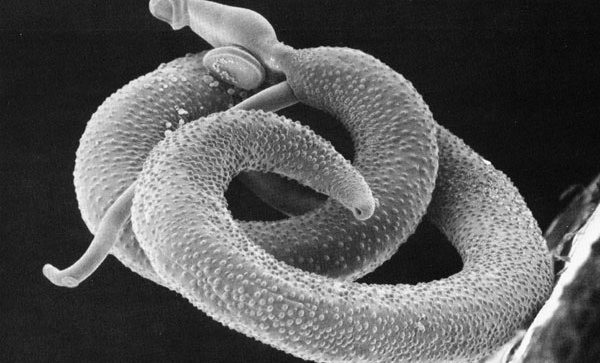Widespread use of pesticides, including the world’s most used herbicide, glyphosate, can speed the transmission of the debilitating disease schistosomiasis (snail fever), while also upsetting the ecological balances in aquatic environments that prevent infections, a new study led by researchers at the University of California, Berkeley has found.

Source: news.berkeley.edu
Schistosomiasis (also known as Snail Fever and Bilharzia) is a disease of poverty that leads to chronic ill-health, according to the World Health Organization. Infection is acquired when people come into contact with fresh water infested with the larval forms (cercariae) of parasitic blood flukes, known as schistosomes. The microscopic adult worms live in the veins draining the urinary tract and intestines. Most of the eggs they lay are trapped in the tissues and the body’s reaction to them can cause massive damage.
Schistosomiasis affects almost 240 million people worldwide, and more than 700 million people live in endemic areas. The infection is prevalent in tropical and sub-tropical areas, in poor communities without potable water and adequate sanitation.
The study, published in the July edition of the journal Lancet Planetary Health, found that agrochemicals can increase the transmission of the schistosome worm in myriad ways: by directly affecting the survival of the waterborne parasite itself, by decimating aquatic predators that feed on the snails that carry the parasite and by altering the composition of algae in the water, which provides a major food source for snails.
“We know that dam construction and irrigation expansion increase schistosomiasis transmission in low-income settings by disrupting freshwater ecosystems,” said UC Berkeley’s Christopher Hoover, a doctoral student in environmental health sciences and lead author of the study. “We were shocked by the strength of evidence we found also linking agrochemical pollution to the amplification of schistosomiasis transmission.”
The findings come as the connections between environment and infectious disease have been laid bare by the COVID-19 pandemic, which is caused by an emerging pathogen thought to be linked to wildlife.
“Environmental pollutants can increase our exposure and susceptibility to infectious diseases,” said Justin Remais, chair of the Division of Environmental Health Sciences at the UC Berkeley School of Public Health and senior author of the study. “From dioxins decreasing resistance to influenza virus, to air pollutants increasing COVID-19 mortality, to arsenic impacting lower respiratory tract and enteric infections — research has shown that reducing pollution is an important way to protect populations from infectious diseases.”
After combing through nearly 1,000 studies gathered in a systematic literature review, the research team identified 144 experiments that provided data connecting agrochemical concentrations to components of the schistosome life cycle. They then incorporated these data into a mathematical model that captures the transmission dynamics of the parasite. The model simulates concentrations of common agrochemicals following their application to agricultural fields and estimates the resulting impacts on infections in the nearby human population.
The researchers found that even low concentrations of common pesticides — including atrazine, glyphosate and chlorpyrifos — can increase rates of transmission and interfere with efforts to control schistosomiasis. Agrochemical amplification of parasite transmission was not inconsequential. In the study communities in the Senegal River Basin in West Africa, the excess burden of disease attributable to agrochemical pollution was on par with disease caused by lead exposure, high sodium diets and low physical activity.
“We need to develop policies that protect public health by limiting the amplification of schistosomiasis (snail fever) transmission by agrochemical pollution,” Hoover said. “More than 90% of schistosomiasis cases occur in areas of sub-Saharan Africa, where agrochemical use is expanding. If we can devise ways to maintain the agricultural benefits of these chemicals, while limiting their overuse in schistosomiasis-endemic areas, we could prevent additional harm to public health within communities that already experience a high and unacceptable burden of disease.”
The research team included Samantha L Rumschlag and Jason R. Rohr of the University of Notre Dame; Luke Strgar of UC Berkeley; Arathi Arakala of the Royal Melbourne Institute of Technology University; Manoj Gambhir, formerly of Monash University, in Melbourne, Australia; and Giulio A. De Leo and Susanne H. Sokolow of Stanford University.




















It is becoming very apparent that these
Types of herbicides and pesticides should
be ban Human health is depending on it